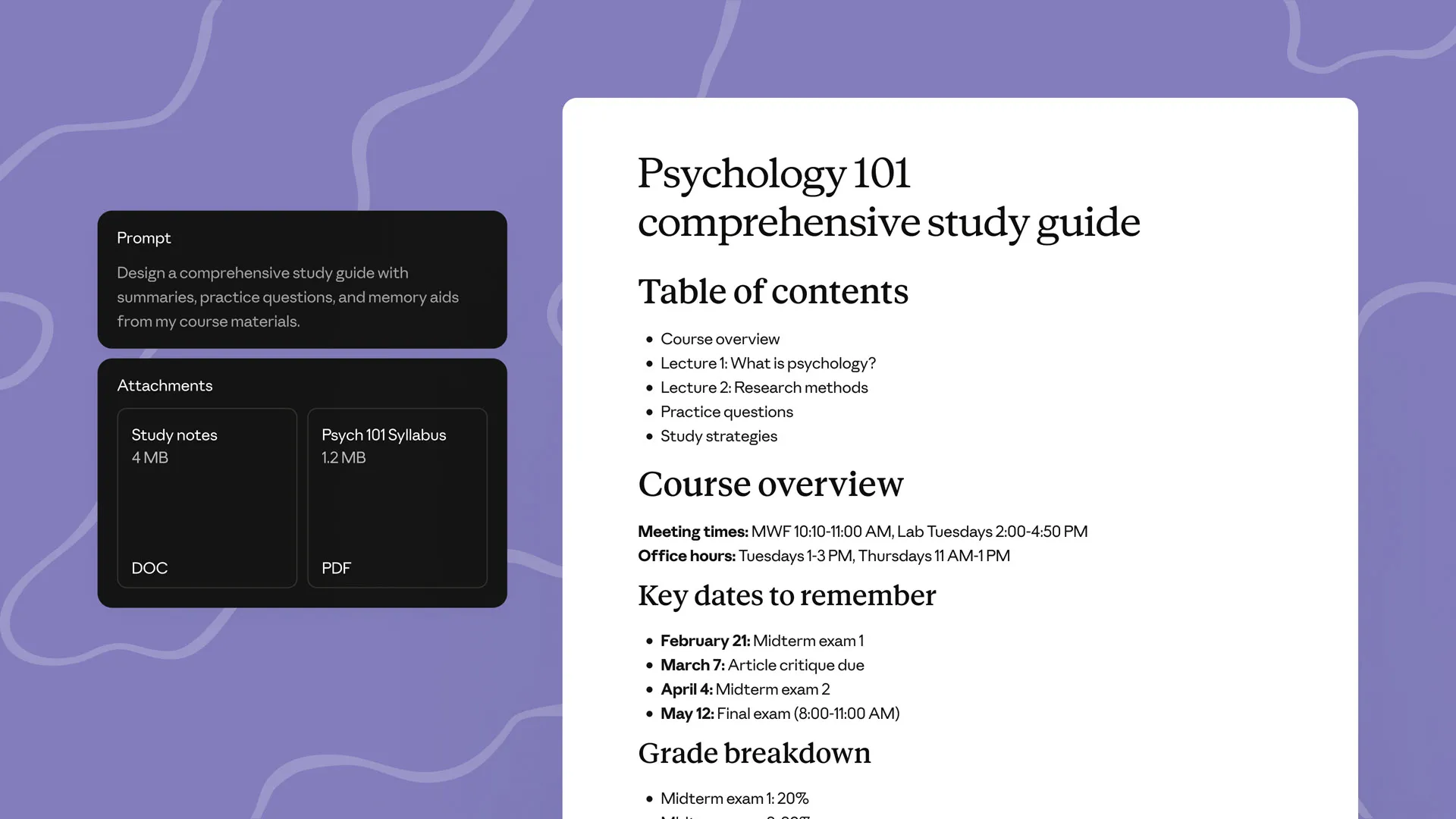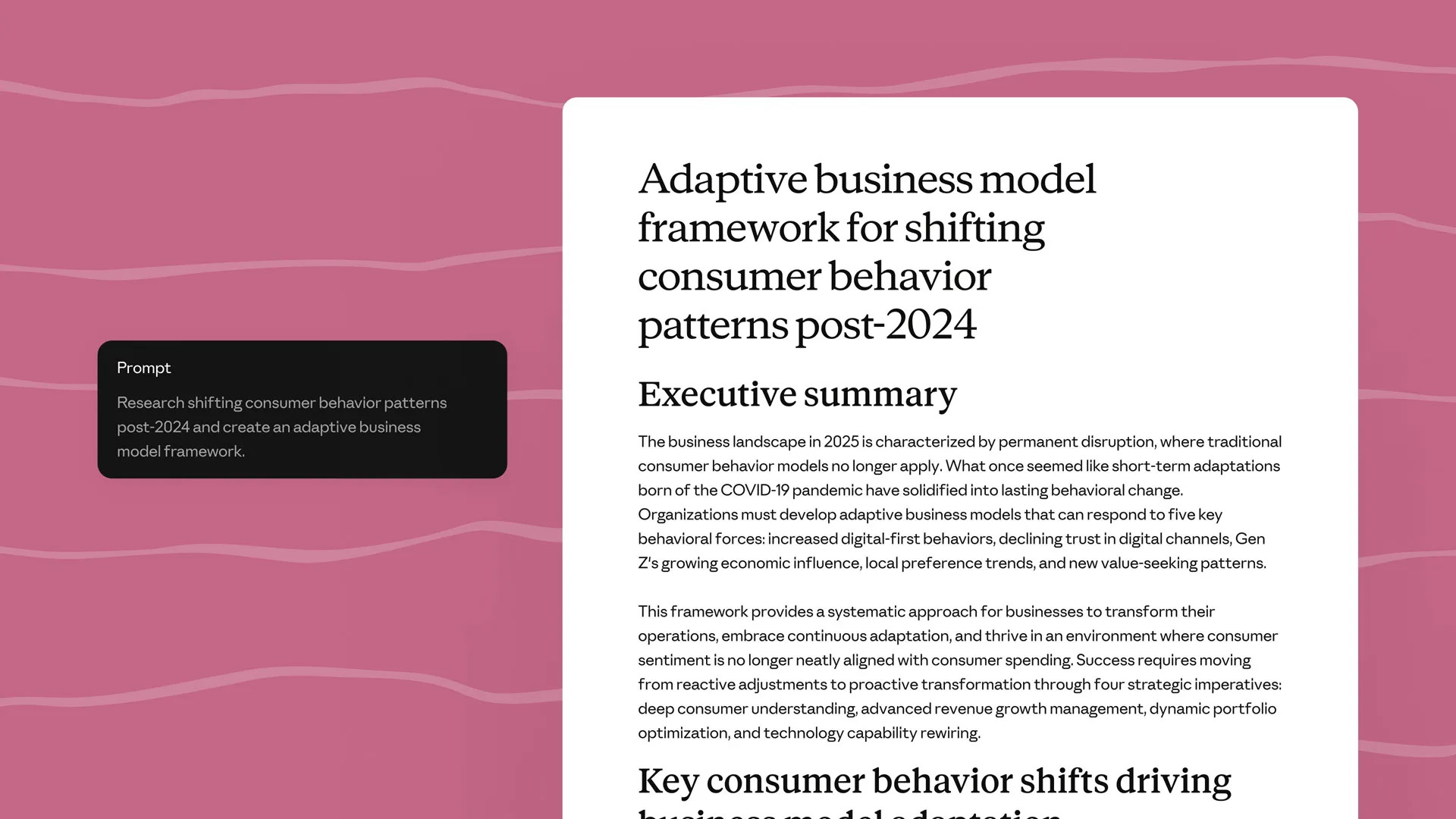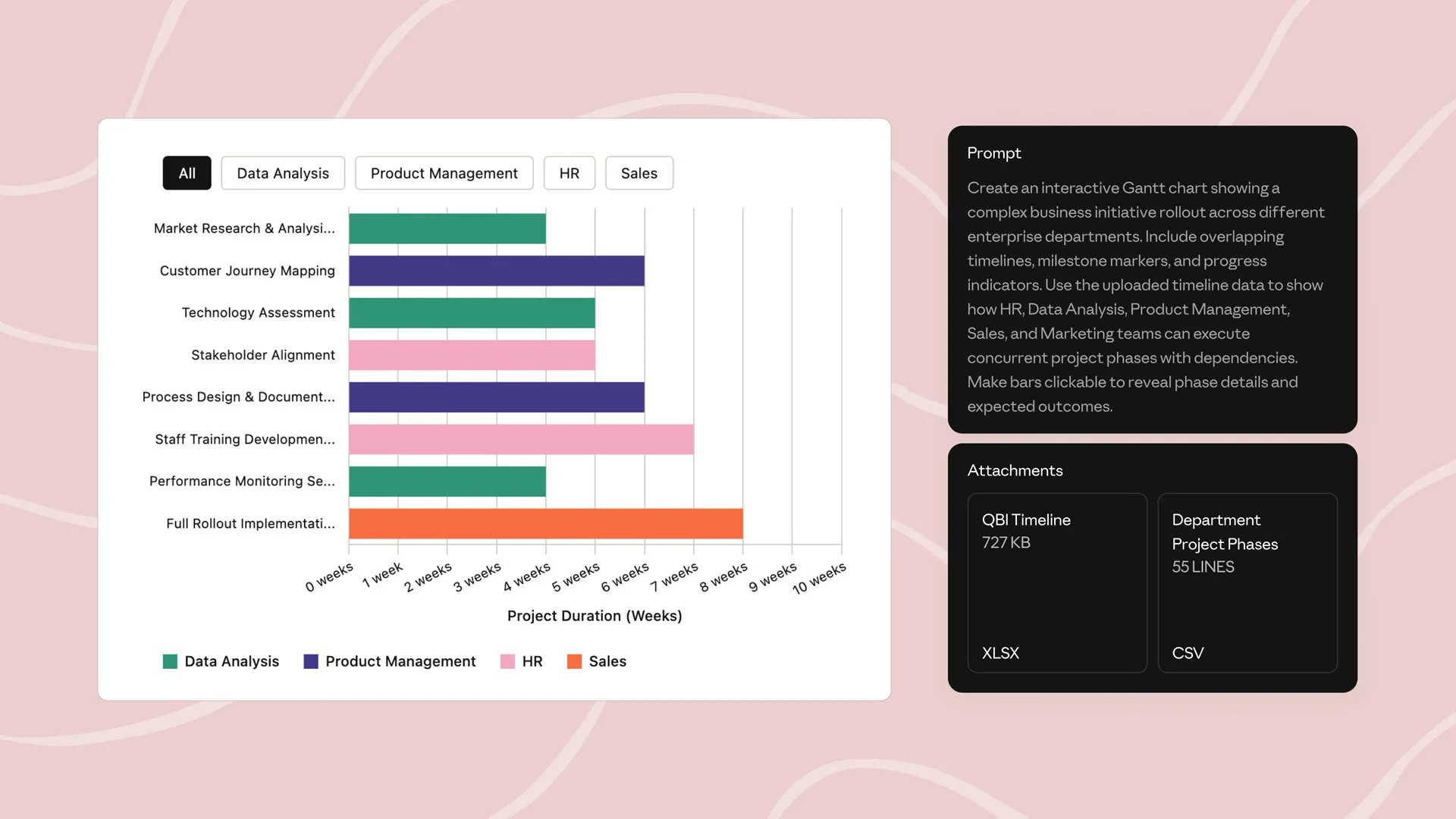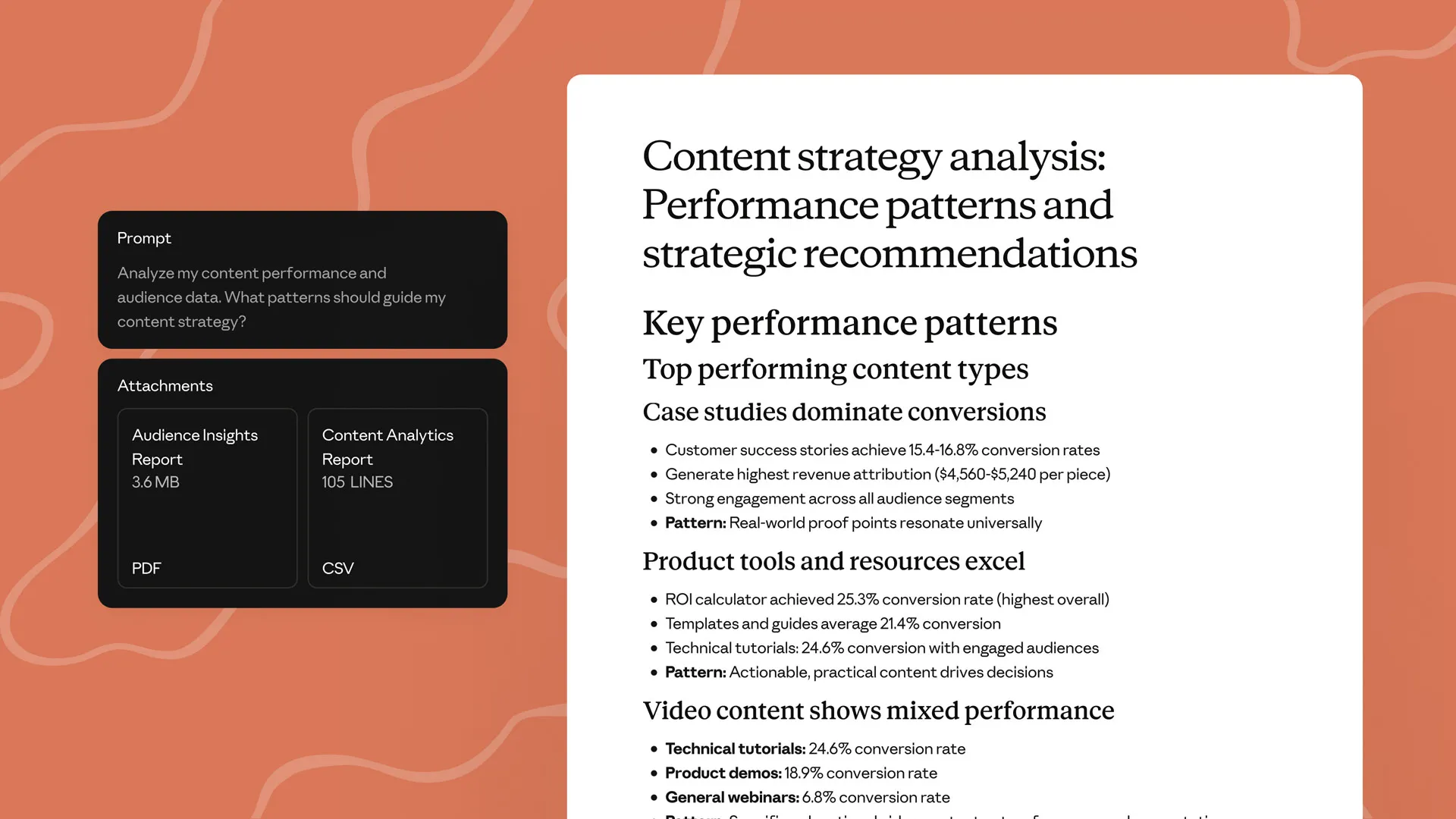- Meet Claude
- Solutions
- Contact sales
- Try Claude
- Contact sales
- Try Claude
Tackle any big, bold, bewildering challenge with Claude.
Claude builds on your ideas, expands on your logic, and simplifies complexity one step at a time.
Claude provides expert-level collaboration on the things you need to get done—from coding a product to critical data analysis.
Like an expert in your pocket, collaborating with Claude expands what you can build on your own or with teams.
Meeting times: MWF 10:10-11:00 AM, Lab Tuesdays 2:00-4:50 PM
Office hours: Tuesdays 1-3 PM, Thursdays 11 AM-1 PM
Psychology = The scientific study of behavior and mental processes
Ancient Greeks: Mind-body problem
Later philosophers:
Note: Observe and describe, cannot determine cause-and-effect
A researcher wants to study the effects of stress on problem-solving but doesn't tell participants they'll be stressed because it might affect their behavior. Is this ethical? What ethical principles are involved?
Remember: Focus on understanding concepts rather than just memorizing facts. Psychology builds on itself, so master these foundations for success throughout the course!

Learn anything through conversation. Upload docs or for deeper insights or create visual study aids with . makes complex topics easier to digest, while keeps your learning organized.
I'll investigate the auth error. Let me look at the relevant files.
Examining auth-related files...
* src/services/authService.js
* src/components/Login.jsx
* src/store/authSlice.js
Running the login flow...
Error detected: "401 Unauthorized: Token expired"
Root cause:
* Token refresh mechanism not handling expired tokens correctly
* Refresh token missing from request header
* Improper error handling for 401 responses
Updating authService.js with proper refresh logic...
Updating request interceptor for 401 handling...
Testing the fix...
* Login successful ✓
* Token refresh working ✓
* Proper redirection on expired tokens ✓
Authentication error fixed! The login flow now properly handles token expiration.

Build anything with intelligent help. Debug , learn new languages, optimize algorithms with clear , or analyze existing .
The business landscape in 2025 is characterized by permanent disruption, where traditional consumer behavior models no longer apply. What once seemed like short-term adaptations born of the COVID-19 pandemic have solidified into lasting behavioral change. Organizations must develop adaptive business models that can respond to five key behavioral forces: increased digital-first behaviors, declining trust in digital channels, Gen Z's growing economic influence, local preference trends, and new value-seeking patterns.
This framework provides a systematic approach for businesses to transform their operations, embrace continuous adaptation, and thrive in an environment where consumer sentiment is no longer neatly aligned with consumer spending. Success requires moving from reactive adjustments to proactive transformation through four strategic imperatives: deep consumer understanding, advanced revenue growth management, dynamic portfolio optimization, and technology capability rewiring.
The behaviors that consumers adopted for coping with life under COVID-19 lockdown—namely, a reliance on digital connectivity and at-home activities—are now permanent parts of their daily lives. This shift has created several critical implications:
Time allocation changes: US consumers in 2025 report that they have over three hours more of free time a week, on average, than those in 2019 reported. But they allocate nearly 90 percent of that time to solo activities. The biggest increases are in hobbies, shopping, fitness, and social media engagement.
Delivery expectations: Food delivery's share of global food service spending rose from 9 percent in 2019 to 21 percent in 2024. Consumers now expect seamless delivery across categories, with over one-third of consumers across all four regions identifying Amazon or Taobao as their go-to shopping destination for all their needs.
Convenience premium: Over 80% of consumers look up brands on platforms like Instagram and TikTok before buying. Almost 70% have made purchases directly through social channels, and nearly 30% buy on the same day they discover something new.
A fundamental contradiction exists in consumer digital behavior. Consumers tell us that social media is their least trusted source when making buying decisions, yet it's where they interact with family and friends, who serve as their most trusted sources. This creates complex dynamics:
Influence vs trust: While social media has low trust ratings, we see an increase in social media use for product research (32 percent, on average, compared with 27 percent in 2023). In emerging markets, approximately half of consumers research products on social media before purchasing.
Cross-generational adoption: Digital engagement is no longer age-restricted. 33 percent of Gen Xers surveyed across Europe and the United States state that they're on TikTok, while 35 percent of baby boomers in those regions report that they're on Instagram.
Gen Zers (born between 1996 and 2010) are projected to make up not only the largest generation but also the wealthiest in history. Their economic impact is substantial:
Income growth: The average 25-year-old Gen Z consumer in the United States has a household income of $40,000, 50 percent higher than the average baby boomer's at the same age.
Spending acceleration: Gen Z spending, which is growing twice as fast as previous generations' spending did at the same age, is on pace to eclipse baby boomers' spending globally by 2029. By 2035, Gen Zers will add an additional $8.9 trillion to the global economy.
Value priorities: Gen Zers across markets are less likely than members of older generations to define themselves based on life stage milestones, such as getting married and having children. They're much more likely, however, to define themselves based on achievements related to financial security.
Financial behavior: Despite financial concerns, more than one-quarter of surveyed Gen Z respondents report using buy-now-pay-later services to make a purchase, and 34 percent of surveyed Gen Zers report a willingness to buy on credit, which is about 13 percentage points higher than other generations.
Over the past five years, we have seen disruptor consumer brands encroach on global, multinational brands. That trend has evolved in 2025: consumers are signaling the importance of buying local from their own markets.
Local preference statistics: Globally, 47 percent of consumers identify locally owned companies as important to their purchase decision. The primary motivation is supporting domestic businesses (36% of consumers), followed by better needs alignment (20%).
Regional variations: This trend is particularly strong in certain markets. In China, six of the top ten beauty brands with the most market share growth since 2020 are Chinese (up from only two from 2015 to 2020). In Japan, nine of the top ten snack brands are Japanese.
Consumer value-seeking behavior has become increasingly sophisticated and cross-category. Rising prices continue to be the number-one cause for concern among consumers across all 18 of the markets in our survey.
Trading down complexity: Globally, 79 percent of surveyed consumers are trading down but not necessarily by purchasing fewer items or seeking discounts at lower-priced retailers. Instead, more than half of surveyed consumers across markets say that they look for deals on every purchase.
Cross-category optimization: Cross-category trade-downs—trading down in one category to afford something in another—are becoming more prevalent. In the first half of 2025, more than one-third of consumers surveyed state that they have traded down in one category while planning to splurge in another.
Splurging persistence: Even among consumers who state that they're concerned about rising prices, over one-third still have plans to splurge, indicating selective value optimization rather than across-the-board reduction.
The adaptive business model framework consists of four interconnected layers that enable organizations to respond dynamically to shifting consumer behaviors:
This framework recognizes that companies must be really good at learning how to do new things. Those that thrive are quick to read and act on weak signals of change.
Organizations must build comprehensive consumer intelligence capabilities that go beyond traditional market research. This includes:
Given the complexity of modern consumer segments, organizations need specialized approaches for different demographic groups:
Understanding how consumers define and seek value requires sophisticated measurement:
Consumer players should strive to generate 20 to 30 percent new revenue from their portfolio every ten years. This requires:
Continuous portfolio evaluation: Regular assessment of brand performance across markets with local preference considerations. Organizations should evaluate which brands can successfully operate beyond core markets and which should be localized or divested.
Strategic M&A approach: Those that leverage M&A&D for growth generate 2.5 percentage points more TSR than those with organic growth alone do. Focus areas include:
Innovation pipeline management: Systematic approach to new product and service development based on emerging consumer behaviors, including convenience-focused offerings and digitally-native experiences.
Offering the right product at the right price at the right time has become more important and harder to do than ever. Advanced RGM requires:
Dynamic pricing strategies: AI-powered pricing models that respond to consumer value-seeking behaviors and cross-category trade-offs.
Personalized promotion deployment: Targeted promotional spending that reaches consumers at optimal moments with relevant offers.
Channel optimization: Strategic presence across discount, wholesale, and premium channels to capture different value-seeking behaviors.
Partnership innovation: Collaborative data sharing with retailers for advanced analytics and retail media activation.
Consumer businesses that make long-term, transformative investments in rewiring for growth could unlock up to a 15-percentage-point improvement in EBITDA margins. Priority areas include:
AI and automation integration: Implementation of agentic AI for consumer insights, demand management, and channel optimization. Among the 140 agentic AI and gen AI use cases that consumer players should prioritize, shaping consumer insights and demand and managing customers and channels represent the greatest value.
Omnichannel infrastructure: Seamless integration across digital and physical touchpoints to meet convenience expectations.
Supply chain agility: Flexible supply chain configuration to support local preferences and rapid portfolio changes.
Data architecture modernization: Real-time data processing capabilities for dynamic decision-making.
Based on changing consumer expectations, organizations must redesign core experiences:
Convenience maximization: Reduction of friction at every touchpoint, with particular focus on delivery speed and reliability.
Trust building mechanisms: Authentic communication strategies that leverage trusted sources like family and friends while maintaining digital presence.
Local market customization: Tailored offerings that reflect local tastes, trends, and cultural preferences.
Value communication: Clear articulation of value propositions that resonate with cross-category optimization behaviors.
Systematic capture and integration of performance data to drive continuous improvement:
Consumer behavior tracking: Regular monitoring of behavioral changes and preference shifts across demographics.
Performance analytics: Real-time assessment of strategic initiative effectiveness with rapid course correction capabilities.
Competitive intelligence: Ongoing analysis of disruptive brands and emerging business models.
Trend anticipation: Proactive identification of weak signals that could indicate major behavioral shifts.
Adaptive strategy execution is a sure-fire way of encouraging flexibility, close communication, and routine operational assessments, ensuring ongoing alignment with internal and external changes. This requires:
Agility mindset: Organization-wide embrace of experimentation and rapid iteration.
Cross-functional collaboration: Breaking down silos to enable rapid response to consumer insights.
Decision authority distribution: Empowering frontline teams to make rapid adjustments based on consumer feedback.
Knowledge sharing systems: Systematic capture and distribution of learnings across the organization.
Build 360-degree consumer view capabilities:
Implement advanced RGM capabilities:
Begin strategic portfolio moves:
Execute major technology transformation:
Transform consumer-facing experiences:
Build responsive operational capabilities:
Create systematic learning and adaptation mechanisms:
Build sustainable differentiation:
Embed adaptive mindset across the organization:
Data privacy and security: As organizations collect more granular consumer data, privacy regulations and security requirements intensify. Mitigation includes implementing privacy-by-design principles, ensuring GDPR and CCPA compliance, and building robust cybersecurity frameworks.
AI model bias and accuracy: Predictive models may perpetuate biases or lose accuracy as consumer behaviors evolve. Regular model auditing, diverse training data, and continuous retraining protocols are essential.
Technology integration complexity: Rewiring technology capabilities involves significant integration challenges. Phased implementation, extensive testing, and change management programs reduce integration risks.
Consumer behavior volatility: Rapid changes in consumer preferences could outpace adaptation capabilities. Building flexible systems and maintaining diverse portfolio options provides resilience.
Competitive response: Competitors may quickly copy successful adaptations. Developing proprietary capabilities and first-mover advantages in niche segments provides differentiation.
Economic disruption: Economic downturns could dramatically shift consumer value-seeking behaviors. Scenario planning and flexible cost structures enable rapid response.
Change resistance: Employees may resist adaptive transformation requirements. Comprehensive change management, clear communication of benefits, and performance incentive alignment support adoption.
Capability gaps: Organizations may lack skills needed for advanced analytics and adaptive operations. Strategic hiring, training programs, and external partnerships address capability needs.
Resource allocation conflicts: Competing priorities may limit transformation investment. Clear ROI demonstration and phased implementation help secure sustained investment.
The post-2024 consumer landscape represents a fundamental shift that requires businesses to move beyond traditional reactive adjustments toward proactive adaptive transformation. A new baseline has emerged for consumer decision-making. Despite a high level of uncertainty—not only in consumer sentiment, but also in geopolitical and economic outlook—there are many areas in which brands can find growth.
Success in this environment requires organizations to embrace four strategic imperatives: building deep consumer understanding capabilities, implementing advanced revenue growth management, continuously optimizing portfolio composition, and rewiring technology capabilities for adaptive operations. Organizations that implement this framework systematically will be positioned to thrive in an environment where outcompeting in the coming years means anticipating the needs of an often-unpredictable consumer.
The adaptive business model framework provides a systematic approach for this transformation, emphasizing continuous learning, rapid experimentation, and consumer-centric decision making. Organizations that successfully implement this framework will not only survive the current disruption but establish sustainable competitive advantages in the evolving consumer economy.
By recognizing that brands that can swiftly adapt to the new realities will be well positioned to grow, regardless of the uncertainty ahead, forward-thinking organizations can transform disruption from threat to opportunity, building resilient business models that thrive on change rather than merely enduring it.
—
This framework synthesizes insights from extensive consumer behavior research across 18 global markets representing 75% of global GDP, incorporating strategic frameworks from leading consulting organizations and academic research on adaptive business systems.

Gather information from everywhere (search the , connect , use custom ) and create interactive reports with reliable in artifacts.

Make sense of anything complex. , create , review documents, evaluate decisions, or break down key choices.
Your content strategy should focus on amplifying what's already working (case studies, technical guides, practical tools) while strategically expanding into underutilized high-conversion opportunities, particularly technical content and video education formats.

Turn ideas into reality. Brainstorm and refine concepts, then bring them to life—from polished to interactive .
Your curiosity’s collaborator
There’s never been a worse time to be a problem, or a better time to be a problem solver.